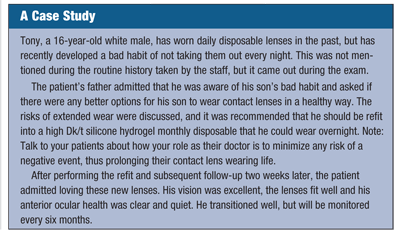Over the years, we have explored a number of ways to derail contact lens dropouts. We credit the recent advances in technology for providing nearly limitless options to keep our patients in their contact lenses. One significant technological advancement is the improvement in oxygen permeability. Increased Dk/t values directly impact daily wear, as we know, but perhaps the significance is even more important to our extended wear patients.
Contemporary contact lens materials, designs, solutions and wearing schedules have fortunately reduced the number of serious contact lens complications we see today. It is important to remember how inconvenient and potentially damaging these complications can be, should they occur.
In this column, we will primarily focus on how extended wear lenses are prescribed and which contact lens materials are appropriate to use.
HEMA vs. SiHy
Dk/t values have long been considered an important factor when evaluating a contact lens material, especially when you consider that some of your patients may be sleeping in their lenses. Overnight wearers need to be closely evaluated; collect important information such as how long the lenses are worn overnight, the replacement schedule and the material of the prescribed lenses.
Some of your extended wear patients may be using older hydrogel material lenses. Research suggests that the much healthier silicone hydrogel (SiHy) lenses, with their higher oxygen permeability levels, produce less corneal edema and neovascularization.1

Corneal infiltrate from sleeping overnight in a HEMA material contact lens.
Even though some traditional soft contacts have extended wear or flexible wear approval, they may not be the best choice for patients seeking overnight lenses. Traditional soft lenses are made from hydroxyethylmethacrylate (HEMA), which relies on the polymer to regulate the amount of oxygen that permeates the lens. With the advent of SiHy contact lenses, the Dk/t increases as the silicone increases.
But remember that the Dk/t varies from the center of the lens out to the periphery. The peripheral cornea may be negatively affected by the lower Dk/t levels in the thicker, peripheral aspect of the contact lens material.2
The limbus is the only source of epithelial stem cells, which help the cornea heal quickly and maintain normal function. If lower Dk/t values in the peripheral contact lens material cause hypoxic inflammation in the limbus, there is the potential for serious complications such as chronic keratitis, vascularization and recurrent erosions.3 Increased oxygen limits the amount of chronic limbal inflammation, so practitioners should continue to use contact lenses with the highest Dk/t values possible. This is especially important for patients who never remove lenses for any period of time.
In addition, the severity of microbial keratitis is lower in the SiHy group when compared to HEMA wearers who sleep in their lenses. For these reasons, SiHy lenses should be the lens of choice for continuous wear patients.
The Overnight Wear Scale
Do you proactively recommend overnight lenses or do you prefer to wait until the patient admits to continuously wearing their lenses without a break? It is each practitioner’s professional decision when and how to introduce this modality, but keep in mind that many patients already internally rationalize overnight wear without your consultation. Can we find these patients before they start overnight use? Perhaps by pre-advising our patients and putting high-risk offenders in SiHy material, we can minimize the risk of marginal keratitis.
 Remember to ask the right questions. Instead of asking if they sleep overnight in their lenses, ask how often they sleep overnight in their lenses. This question carries more weight if you ask it while performing the slit lamp exam. Either way, this inquiry needs to be discussed and repeated at each contact lens evaluation.
Remember to ask the right questions. Instead of asking if they sleep overnight in their lenses, ask how often they sleep overnight in their lenses. This question carries more weight if you ask it while performing the slit lamp exam. Either way, this inquiry needs to be discussed and repeated at each contact lens evaluation.
Non-compliance is already a serious issue, and the problem can worsen if you are not diligent. Several factors contribute to the issue, including age, education, wear schedule, when your patient was first fit in lenses and why they chose that particular modality.
Non-compliance in the medical care field is as high as 44%; yet non-compliance in contact lens care ranges between 50% and 99%.5 This is why we, as an eye care community, need to be consistent in how we educate and prescribe specific lenses.
1. Holden BA, Mertz GW. Critical oxygen levels to avoid corneal edema for daily and extended wear contact lenses. Invest Ophthalmol Vis Sci. 1984 Oct;25(10):1161-7.
2. Stapleton F, Stretton S, Papas E, et al. Silicone hydrogel lenses and the ocular surface. Ocul Surf. 2006 Jan;4(1):24-43.
3. Covey, M, Sweeney DF, Terry RL, et al. Hypoxic effects on the anterior eye of high Dk soft contact lens wearers are negligible. Optom Vis Sci. 2001 Feb;78(2):95-9.
4. Szczotka-Flynn L, Insua D. Risk of infiltrates and CLPC with traditional hydrogel and silicone hydrogel extended wear: A meta analysis. Invest Ophthalmol Vis Sci. 2005;46:E-Abstract 2067.
5. Donshik PC, Ehlers WH, Anderson LD, Suchecki JK. Strategies to better engage, educate, and empower patient compliance and safe lens wear: compliance: what we know, what we do not know, and what we need to know. Eye Contact Lens. 2007 Nov;33(6 Pt 2):430-3, discussion 434.


